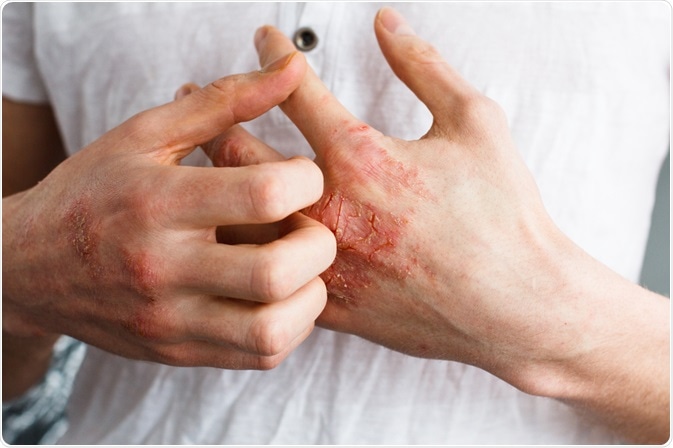There are several types of skin problems, which can be caused by genetic conditions, allergies, irritants, or impaired immune systems. In addition, skin problems can be associated with certain diseases.

Image Credit: Ternavskaia Olga Alibec/Shutterstock.com
Acne
Acne is the most common type of skin problem characterized by pus-filled bumps/spots on the skin. The spots appear mainly on the face; however, acne can also occur on the back, shoulders, chest, and neck.
There are pores on the skin that are connected to the skin’s oil-producing glands (sebaceous glands) via hair follicles. Sebaceous glands, which produce sebum, are sensitive to hormonal changes.
During puberty, alteration in hormonal levels trigger the production of sebum, which can block hair follicles. Also, dead skin cells obstruct the follicle, causing the formation of painful bumps on the skin.
The human skin contains one type of bacterium called Propionibacterium acnes. In people with acne, accumulation of oil on the skin provides an optimal environment for these bacteria to grow rapidly and multiply. This causes skin inflammation and the formation of pus-filled bumps.
Acne can be treated with a variety of over-the-counter and prescription medications. Topical formulations containing benzoyl peroxide or salicylic acid tend to be first treatment choices and can provide adequate control for many people.
Also, antibiotics can be used to reduce bacteria-induced inflammation. In women, low-dose oral contraceptive medicines can be used to reduce acne by modulating the hormone level in the blood.
Vitamin A-containing medicines may also be helpful. However, oral vitamin A derivatives can cause severe birth defects, so any woman receiving a prescription must have a pregnancy test before beginning therapy and continue to have pregnancy tests each month while using the medication. She should use a highly effective form of birth control while using oral vitamin A medications.
Eczema
Eczema is a very common form of skin problem associated with inflammation. Eczema is primarily caused by a genetic- or environmental factor-induced alteration in the skin barrier, which can make a person more susceptible to allergens and bacteria/virus-induced infections.
As a result, allergens or irritants can easily enter the skin and induce inflammation and itching.
People with eczema are particularly susceptible to bacterial or viral infections. In most cases, staphylococcal infections can make the skin yellow, hard, and inflamed. Moreover, herpes simplex virus infection can abruptly increase the eczema symptom intensity.
Although there is no cure for eczema, the condition can be managed with medicated moisturizers, topical steroid creams or ointments, topical calcineurin inhibitors, antibiotics and antiseptics, and antihistamine medicines. The severity of eczema often decreases with age.
Alopecia areata
Alopecia areata is a type of skin problem that affects the hair follicles and causes hair loss. The condition typically causes small, round-shaped patches of baldness on the head; however, hairs on the beard, eyebrows, eyelashes, or other body parts can also be affected by the condition.
Although the exact etiology is unknown, alopecia areata is believed to be an autoimmune disorder wherein the body’s immune system attacks the hair follicles and inhibits hair growth.
Most of the treatment strategies aim at triggering the hair regrowth. Topical steroid creams, localized steroid injections, or oral steroid medicines are usually used to treat alopecia areata.
In addition, contact sensitization treatment (used to create mild inflammation and induce regrowth), ultraviolet light treatment (used to induce regrowth by making the skin sensitive to light), and immunosuppressant medicines can be used to treat the condition.
Contact dermatitis
Contact dermatitis is a type of skin inflammation that can be caused by direct skin contact with the causative factor. The condition is similar to eczema.
There are two types of contact dermatitis: irritant contact dermatitis that is caused by direct skin contact with irritants, such as detergents and solvents; and allergic contact dermatitis that is caused by allergies developed due to direct skin contact with allergic materials, such as perfumes, hair dye chemicals, certain metals, etc.
The most common symptoms of contact dermatitis are itching, skin redness, and blister formation. The skin can also become dry and thickened.
The best way to prevent contact dermatitis is to avoid direct skin contact with causative substances. It is also helpful to wear gloves or to improve skin barrier with good moisturizers. To reduce inflammation, steroid creams can be used. In severe cases, doctors may prescribe oral steroid medicines and antibiotics.
Keratosis pilaris
Keratosis pilaris is a very common and harmless skin condition characterized by small, whitish or reddish patches or bumps on the skin. About 50 – 70% of adolescents and 40% of adults are affected by the condition.
The condition is generally caused by excessive accumulation of keratin on the skin, which in turn blocks the skin pores and hair follicles, causing hard bumps to form. In about 50% of cases, the condition is hereditary.
Although there is no permanent cure for keratosis pilaris, the symptoms can be reduced using creams containing vitamin A, urea, lactic acid, salicylic acid, or alpha-hydroxy acids. Also, laser therapy, photodynamic therapy, or topical corticosteroids can be helpful.
Lichen planus
Lichen planus is a relatively uncommon skin condition affecting about 0.2 – 1% of the general population globally. The condition is characterized by itchy small, flat, rashes on the skin. In some cases, it occurs on the lips and inside the mouth.
Although the exact etiology is unknown, it is believed to be caused by hyperactivation of the skin’s immune system. Certain risk factors can increase the chance of lichen planus. These include viral infection, blood pressure reducing medicines or anti-malarial medicines, and stress and anxiety.
In most cases, the condition is treated by steroid creams or oral steroid medicines. In addition, narrow-band ultraviolet treatment can be used.
Further Reading
Last Updated: Mar 20, 2020